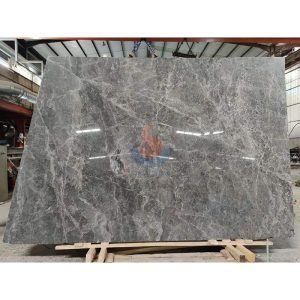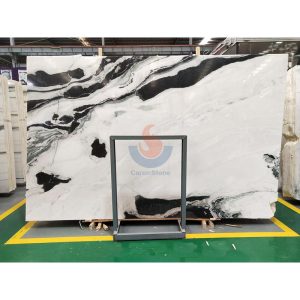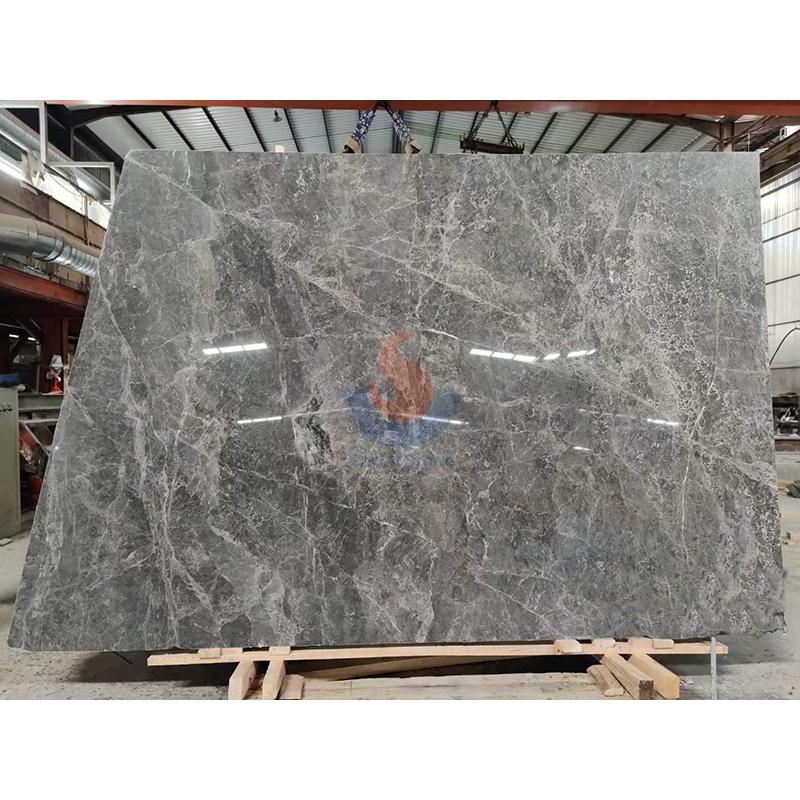Marble has to be the decorative element that has been copied but never exceeded.
Slate and marble have somewhat similar appearances. From marble to the popular slate today, the restoration and realism of imitation stone products of ceramic enterprises have reached a superb level. Slate and marble have somewhat comparable surfaces, thus slate can be considered as an advanced form of marble.

Grey Vein Cross Marble
Source and appearance
Marble
Marble comes from the ground, hence every piece has a different texture. Excellent stone boasts rich and varied colors as well as clear, delicate, smooth textures.
Slate
Slate is produced through industrial equipment, so the appearance of the same slate is highly consistent, although the texture is close to natural stone. But the present slate variations available on the market are somewhat solitary, with black, white, and gray being the main hues.
Physical and chemical properties
Due to the different sources and ingredients, the physical and chemical properties of the two are completely different, which makes their use in home decoration have obvious advantages and disadvantages.
01. Hardness
Mohs hardness of Stone Board is 6–7, wear-resistant, scratch-resistant, impact-resistant. On the kitchen island, it will not wear out when cutting vegetables.
Marble: Mohs hardness is 2.5-5, which is relatively fragile and afraid of being scratched and hit by hard objects. You may scratch it easily. Still, it’s simple to handle, carve, grind, polish, etc.; you may create several patterns out of it.
02.density
With a water permeability of just 0.02%, Stone Board is denser and more homogeneous than Marble; its waterproof and anti-fouling properties are much better.
Marble: It is relatively loose, and varies greatly according to different varieties and grades. Water is easy to absorb and loses gloss after long use. It is inappropriate for usage in bathroom and kitchen areas.
03. Stability
Stone board: It has very high stability, is durable, will not change color or deform, and meets various needs of daily home use.
Marble: The calcium carbonate contained in it is easily weathered and dissolved by carbon dioxide, carbide, and water vapor in the atmosphere. It is more suitable for indoor spaces and not suitable for outdoor use.
04. Temperature resistance
Stone board: It can withstand high temperatures up to 2000 degrees Celsius without leaving any traces. You could prepare straight on it.
Marble: There are various gaps inside the quite loose construction. High temperatures cause the air in the gaps to expand under heat and becomes readily broken.
05. Acid and alkali resistance
Stone board: The main component is silicon dioxide, which has strong acid and alkali resistance. Not reacting with it will be general acid and alkaline compounds.
Marble: Calcium carbonate makes up most of it; it will chemically react with acid and alkali. It is easily chemically reacted upon and not acid and alkali resistant.
06. Fire resistance
Stone board: It is not afraid of fire, even if it is directly baked with an open flame, there will be no problem.
Marble: It cannot burn directly, and the high temperature caused by the fire will cause it to break.
Application scenario
Commercial space
Commercial space, including the lobby scene, is notable in that there is a lot of paving demand and marble is typically utilized to create an atmospheric environment.
However, when paving marble over a large area, there will be problems with color difference and texture connection. Solving the issue depends mostly on the highly adjustable color and (infinite) continuous pattern design of granite slabs.
Bathroom and kitchen areas
Rock slabs are a good choice for kitchen islands and various cabinet doors due to their high temperature resistance, wear resistance, and compact structure.
Marble has natural textures and distinctive feel; solid transparency is another feature. For desks and counters, it is also a decent material. Apart from stone counters, tables and coffee tables with metal table frames also reflect greater luxury and style.
Living room space
Rock slabs have application in several fields. At less cost, they can be placed on the ground and on the wall to fulfill the design requirements of modern high-end house décor. They can also be used to improve the sense of quality and style even on furniture like TV cabinets and coffee tables.
Marble is utilized mostly for paving and background walls. Natural marble is difficult to arrange on the wall because of its own weight. In improper handling, inadvertent sliding off is really prevalent.
Due to its characteristics, marble can also be carved into practical artworks such as arts and crafts, stationery, lamps, and utensils. It is a perfect material for decorating opulent buildings and a classic for artistic carving with its soft, gorgeous and serious texture and elegant design.

Panda White Marble Bookmatch Slab Wall Shower Flooring
Which is better, slate or marble? Slate performs better from the above comparison, but there is no one material that would be absolutely suitable for decoration. Still, the style will determine it.





